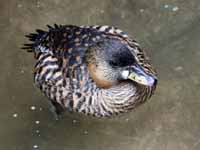BIRDS of THE WORLD - An Online Bird Book
WATERFOWL
Order Anseriformes Family Anatidae
WATERFOWL
Order Anseriformes Family Anatidae
The order Anseriformes contains about 150 living species of birds All species in the order are web-footed for efficient swimming and have a large wide bill with a specialized tongue that allows water to be sucked in the front of the bill. An array of plates traps food particles as the water is expelled out the sides of the bill. Not all species feed this way, some graze on plants and some also catch fish.
Anseriformes has 3 familes, but almost all of the species belong to Anatidae.
Family Anatidae: dabbling ducks, teals, diving ducks, sea duck, shelducks, geese.
Family Anatidae: stiff-tailed ducks, swans, whistling ducks,
Family Anhimidae: screamers
Family Anseranatidae: magpie goose
Other species resemble the waterfowl of Anseriformes.
Order Gaviiformes, Family Gaviidae: loons
Order Gruiformes, Family Rallidae: coots, moorhens, crakes, rails
Order Podicipediformes, Family Podicipedidae: grebes
Whistling-Ducks
Anseriformes has 3 familes, but almost all of the species belong to Anatidae.
Family Anatidae: dabbling ducks, teals, diving ducks, sea duck, shelducks, geese.
Family Anatidae: stiff-tailed ducks, swans, whistling ducks,
Family Anhimidae: screamers
Family Anseranatidae: magpie goose
Other species resemble the waterfowl of Anseriformes.
Order Gaviiformes, Family Gaviidae: loons
Order Gruiformes, Family Rallidae: coots, moorhens, crakes, rails
Order Podicipediformes, Family Podicipedidae: grebes
The whistling-ducks have long legs and necks, and are very gregarious, flying to and from night-time roosts in large flocks. Both sexes have the same plumage, and all have a hunched appearance and black underwings in flight. Their name refers to their loud whistling-like call.
Genus Dendrocygna
Duck, Black-bellied Whistling- Dendrocygna autumnalis Found: The Americas
The Black-bellied Whistling-Duck has chestnut brown back, crown, lower neck, and breast; pale gray head, face, and upper neck; black belly and tail; long red bill, white eye-ring. Juveniles are similar but have a gray bill and less contrasting belly.
Image by: 1) Dick Daniels - San Diego Zoo 2) Sandy Cole - San Diego Zoo 3) Mathew High - Texas4, 5, 6, 7) Dick - Sylvan Heights 8) Alan D. Wilson

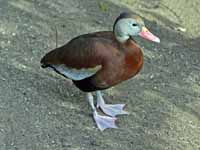





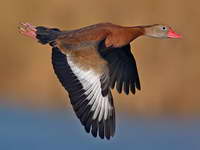
Duck, Fulvous Whistling- Dendrocygna bicolor Found: The Americas, Africa, south Asia
The Fulvous Whistling-Duck has dark gray back and wings; gray bill, buff head and underparts; reddish-tinged on the flanks; dark line down center of nape.
Similar to: Lesser Whistling-Duck. The Lesser Whistling-Duck has chestnut rump (upper tail coverts); the Fulvous Whistling-Duck has creamy coverts. Fulvous Whistling-Duck has dark line down center of nape; Lesser Whistling-Duck does not.
Similar to: Wandering Whistling-Duck. The ranges do not overlap.
Image by: 1, 4, 5, 6, 7, 8) Dick Daniels - Sylvan Heights 2, 3, 9) Dick - Birds of Eden, South Africa Similar to: Lesser Whistling-Duck. The Lesser Whistling-Duck has chestnut rump (upper tail coverts); the Fulvous Whistling-Duck has creamy coverts. Fulvous Whistling-Duck has dark line down center of nape; Lesser Whistling-Duck does not.
Similar to: Wandering Whistling-Duck. The ranges do not overlap.
10, 11) Sandy Cole - Birds of Eden, Sylvan Heights
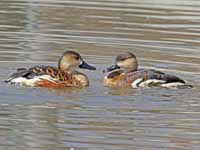





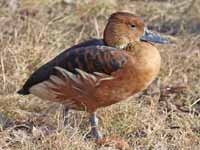
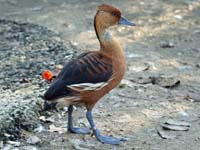
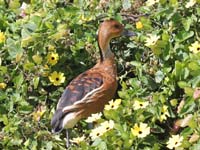
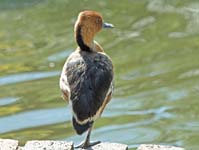
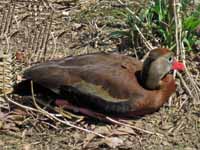
Duck, Lesser Whistling- also Indian Whistling-Duck Dendrocygna javanica Found: south Asia
Similar to: Fulvous Whistling-Duck. The Lesser Whistling-Duck has chestnut rump (upper tail coverts); the Fulvous Whistling-Duck has creamy coverts.
Image by: 1) Thimindu - Sri Lanka 2, 5, 6) Dick Daniels - Sylvan Heights 3) Fiorellino - Walsrode Bird Park, Germany 4) Lip Kee - Singapore 7) Gaurika Wijeratne - Sri Lanka
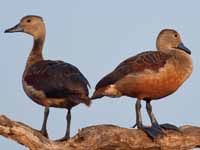
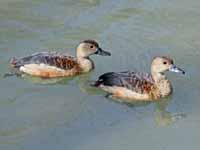



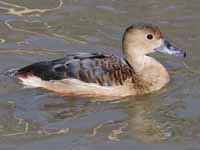

Duck, Plumed Whistling- Dendrocygna eytoni Found: Australasia
The Plumed Whistling-Duck has dark gray back and wings, reddish-tinged on the flanks, buff head and underparts, dark gray bill.
Image by: 1) Arthur Chapman - Queensland 2) Helen - Perth 3) Glen Fergus - Queensland4) Dick Daniels - Sylvan Heights 5) Trevor Anderson - Australia

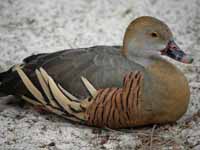
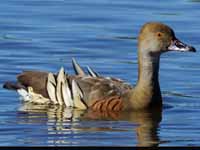
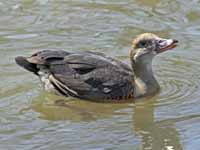

Duck,_Spotted_Whistling- Dendrocygna guttata Found: Philippines, Australasia
The Spotted Whistling-Duck has dark brown back, crown, breast and wings; white spots on underparts, light brown face, black bill.
Similar to: Maned Duck. Both species have spots on the breast, but heads are very different.
Image by: 1) Tony_Morris 2, 3) Dick Daniels - Sylvan Heights 4) Aviceda - QueenslandSimilar to: Maned Duck. Both species have spots on the breast, but heads are very different.
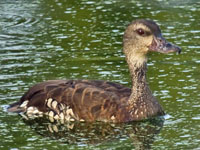
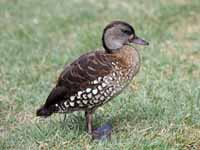
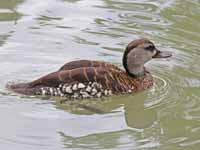
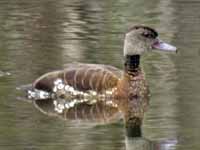
Duck, Wandering Whistling- Dendrocygna arcuata Found: Philippines to Indonesia, Australasia
The Wandering Whistling-Duck has long neck, legs. It looks like a cross between a goose and a duck. It has a strong head and neck with a darker crown and hindneck. The breast contains black spotting and the feathers are mostly dark brown.
Similar to: Fulvous Whistling-Duck. The ranges do not overlap.
Image by: 1) Aviceda 2) Jerry Oldenettel - Papua New Guinea 3) James Cheuk - Borneo 4, 5) Brian Gratwicke Similar to: Fulvous Whistling-Duck. The ranges do not overlap.
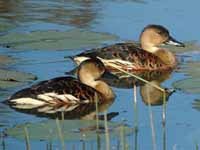


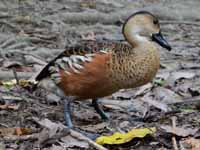

Duck, West Indian Whistling- Dendrocygna arborea Found: The Caribbean
The West Indian Whistling-Duck is the only Whistling-Duck in the Americas that has white spots on its belly.
Image by: 1, 2, 4) Dick Daniels - Jamaica 3) Dick - Puerto Rico at the Mayaquez Zoo
5, 6, 7, 8) Dick - Sylvan Heights 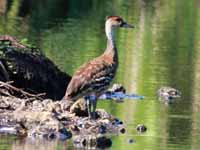

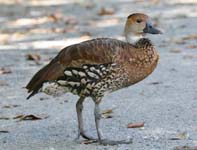


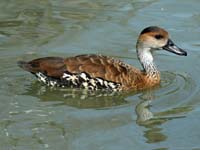
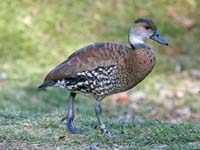
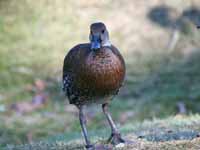
Duck, White-faced Whistling- Dendrocygna viduata Found: Costa Rica to Brazil, Africa
The White-faced Whistling Duck has a white face and crown, black rear head. chestnut neck and breast, dark brown to black back, dark gray bill.
Similar to: female Cape Shelduck. White-faced Whistling-Duck has a vertical black-white boundary on head; female Cape Shelduck black-white areas on head are more random.
Image by: 1, 2) Dick Daniels - Sylvan Heights 3, 6) Dick - Parc Tsarasaotra (open bird sanctury in Antananrivo, MadagascarSimilar to: female Cape Shelduck. White-faced Whistling-Duck has a vertical black-white boundary on head; female Cape Shelduck black-white areas on head are more random.
) 4, 5) Dick - Birds of Eden, South Africa 7) Bernard_Dupont - South Africa 8) Claudio_Timm
6) With Red-billed Duck
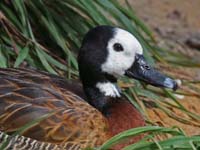


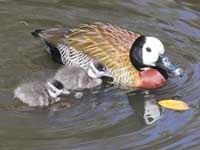
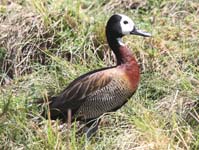



Genus Thalassornis - 1 species
It is not clear what the nearest relative is of the White-backed Duck, perhaps the Whistling-Ducks.
Duck, White-backed Thalassornis leuconotus Found: southern Africa
The White-backed Duck eat bulbs of waterlilies, but also seeds and leaves of waterlilies and other water plants and the young feed on lake flies larvae as well.
Image by: 1, 2, 3) Dick Daniels- Sylvan Heights 4) Dick - San Diego Zoo


